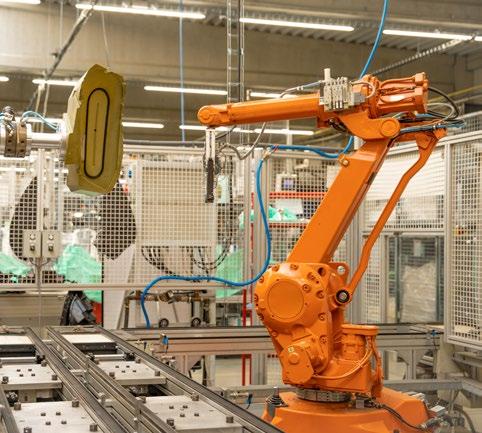
5 minute read
Industry 4.0: Managing the Cultural Impact in Manufacturing
Andy Coussins, senior vice president and head of international at Epicor Software, discusses the six steps for a successful change management strategy.
The success of digital transformation isn’t just about investing in the right technology. As with any large-scale project—from a change in working location to a company merger—the impact on the people involved needs to be a key consideration when putting a strategy and implementation plan in place. However, in a bid to keep up with the latest technology trends, manufacturers could be shooting themselves in the foot by not addressing change management and cultural aspects from the outset.
In fact, recent research has found that only a quarter (26%) of businesses consider change management strategies to be an important part of the move towards Industry 4.0 and the connected enterprise. This suggests that a large proportion of manufacturers are not putting steps in place to manage the impact of such a change on corporate culture, which could affect the ultimate success of any digital transformation project.
Six steps to success
Despite pressure on businesses and individuals to remain at the cutting edge, no one wants to be an early adopter and get it wrong. A recent report from Deloitte into Industry 4.0 readiness found that even in today’s technologydriven world, senior executives are not as prepared as they think they are to reap rewards from digital transformation.
“Faced with an ever-increasing array of new technologies, leaders acknowledged they have too many options from which to choose and, in some cases, they lack the strategic vision to help guide their efforts. Organisational influences also challenge leaders as they seek to navigate Industry 4.0. Many leaders reported their companies don’t follow clearly defined decision-making processes, and organisational silos limit their ability to develop and share knowledge to determine effective strategies.”
To make Industry 4.0 a success, no matter how big or small the change, manufacturers need to put key measures in place to manage the transition. This includes undertaking the necessary groundwork to ensure that whatever technology businesses invest in, they can get the best out of it.
Despite digital transformation being very much an industry buzzword, manufacturers don’t need to take everything on at once. It’s important to assess what needs to be automated and why. If something is working and the process is efficient, it might not need changing just yet. The key to getting it right is to prioritise adoption rather than change for change’s sake. A phased approach will be beneficial for everyone in the long term.
Step two— Get stakeholders on board
Following an assessment of priorities, manufacturers need to map and plan out what needs to happen next—from procurement to implementation and beyond. This ensures that all stakeholders from every department affected are clear about what is happening, why, and when. Only then can everyone involved be prepared and plan for the roll-out.
Step three— Keep talking
Communication at every stage is essential particularly before implementation. Users need to feel they are part of the process and that they can raise any concerns or questions before a new way of working is thrust upon them. Taking time to address any potential issues at the start of a project will ensure users are bought into the process, enable them to understand what is expected of them, and avoid any pitfalls further down the line.
Step four— Factor in ongoing training and support
For efficiencies and productivity to be realised, users need to have a good understanding of how the technology impacts their working practices. This can only be done through comprehensive training and ongoing support. While this could be an overwhelming prospect, breaking it down into bite-sized, digestible sessions will be more effective, rather than overloading people with too much information from the outset.
It is also worth considering that everyone learns in different ways, so whilst an online demo or training manual might be right for one person, someone else might prefer more visual tools, like a video or a step-by-step animated guide, for example.
Step five— Take your time
The choice of new technologies can be overwhelming and daunting for even a seasoned professional. Never lose sight of why you are investing in technology and keep your business objectives in mind—what your competitor is doing might not be the right approach for you. Jumping on the bandwagon or adopting new technology too quickly could be detrimental in the long-term, if the process is not well thought-through or fit for purpose.
Step six— Undertake regular reviews
While following steps one to five will ensure your business has the best chance of successfully adopting new technology, it will all be in vain if you miss out step six. The hard work doesn’t stop when you reach go-live—in fact, that is only just the start of the digital transformation process.
For a project to be a true success, any technology investment needs to be reviewed and assessed regularly. Is it being used to its full potential? Are there any gaps in training? What more could the business get from it? What is the data showing? Can it be analysed to improve future business growth?
Only by following these six steps will the manufacturing industry bring the whole business along for the digital transformation ride and ensure that Industry 4.0 is a success. Having a clear change management and implementation strategy will enable businesses to realise the full value of technology, whilst guaranteeing strong ROI and user acceptance.

The success of digital transformation isn’t just about investing in the right technology. As with any large-scale project—from a change in working location to a company merger—the impact on the people involved needs to be a key consideration when putting a strategy and implementation plan in place. However, in a bid to keep up with the latest technology trends, manufacturers could be shooting themselves in the foot by not addressing change management and cultural aspects from the outset.

